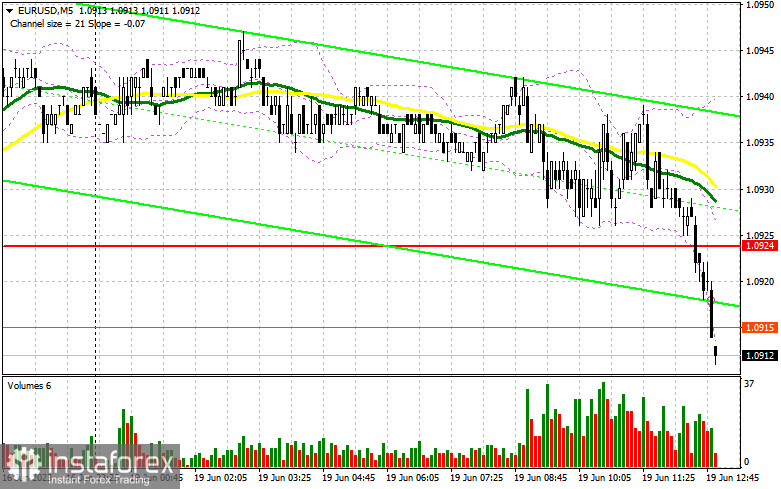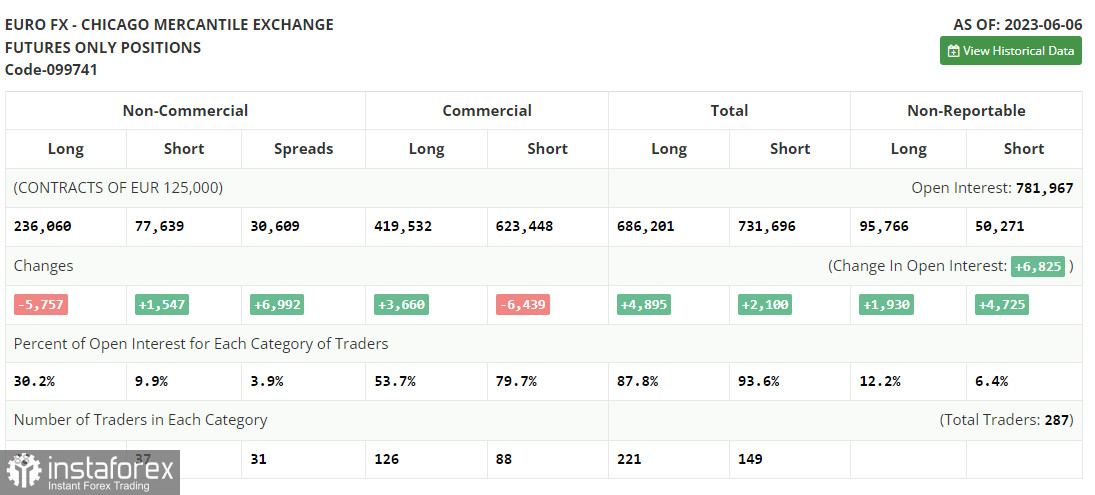In my morning article, I turned your attention to 1.0924 and recommended making decisions with this level in focus. Now, let's look at the 5-minute chart and figure out what actually happened. A fall to 1.0924 occurred without a false breakout. Bulls did not show any activity at this level. For the afternoon, the technical outlook was slightly revised.

When to open long positions on EUR/USD:
The lack of macro stats from the US may help sellers enter the market. However, they will hardly be able to initiate a long downward movement of the pair. Traders are likely to ignore the NAHB Housing Market Index. I would advise you to rely more on technical levels. I will go long near the support level of 1.0900, formed last Thursday after a rate hike by the ECB. Only a false breakout there, similar to the one I mentioned in my morning forecast, will give a buy signal. The pair could rise to the resistance level of 1.0937. A breakout and a downward retest of this level will bolster demand for the euro. The pair may reach 1.0970. A more distant target will be the 1.1002 level where I recommend locking in profits.
If EUR/ USD declines and bulls fail to protect 1.0900, in the afternoon, bears may return to the market expecting to build a downward correction. Therefore, only a false breakout of the support level of 1.0862 will provide new entry points for long positions. You could sell after a bounce from the low of 1.0818, keeping in mind an upward intraday correction of 30-35 pips.
When to open short positions on EUR/USD:
Sellers managed to push the pair down in the morning. However, it will hardly lead to a trend reversal. Bulls are waiting for more favorable prices. This is why a sharp drop in the euro looks unlikely. For this reason, I would prefer to go short only after a rise and a false breakout of the resistance level of 1.0937, formed in the morning. The moving averages are also passing at this level. An unsuccessful consolidation there may create a sell signal that could push EUR/USD to 1.0900. A decline of this level as well as an upward retest could trigger a fall to 1.0862. A more distant target will be a low of 1.0818 where I recommend locking in profits.

If EUR/USD rises during the US session and bears fail to protect 1.0937, the market equilibrium will occur. The pair will slide in a sideways range. In this case, I would advise you to postpone short positions until a false breakout of the resistance level of 1.0970. You could sell EUR/USD at a bounce from 1.1002, keeping in mind a downward intraday correction of 30-35 pips.
COT report
According to the COT report (Commitment of Traders) for June 6, there was a drop in long positions and a slight increase in short ones. Despite all this, the Fed's rate decision this week may significantly affect market sentiment. Hence, the above-mentioned changes are not important. If the Fed decides to skip a rate increase, the euro will climb markedly. Risk appetite will improve amid the ECB's commitment to a hawkish stance even despite the first signs of a slowdown in inflationary pressure. The COT report showed that long non-commercial positions decreased by 5,757, to 236,060, while short non-commercial positions rose by 1,457, to 77,060. At the end of the week, the total non-commercial net position declined and amounted to 158,224 against 163,054. The weekly closing price dropped to 1.0702 against 1.0732.

Indicators' signals:
Trading is carried out near the 30 and 50 daily moving averages, which indicates market uncertainty.
Moving averages
Note: The period and prices of moving averages are considered by the author on the H1 (1-hour) chart and differ from the general definition of the classic daily moving averages on the daily D1 chart.
Bollinger Bands
If EUR/USD rises, the indicator's upper border at 1.0960 will serve as resistance.
Description of indicators
- Moving average (moving average, determines the current trend by smoothing out volatility and noise). Period 50. It is marked yellow on the chart.
- Moving average (moving average, determines the current trend by smoothing out volatility and noise). Period 30. It is marked green on the chart.
- MACD indicator (Moving Average Convergence/Divergence - convergence/divergence of moving averages) Quick EMA period 12. Slow EMA period to 26. SMA period 9
- Bollinger Bands (Bollinger Bands). Period 20
- Non-commercial speculative traders, such as individual traders, hedge funds, and large institutions that use the futures market for speculative purposes and meet certain requirements.
- Long non-commercial positions represent the total long open position of non-commercial traders.
- Short non-commercial positions represent the total short open position of non-commercial traders.
- Total non-commercial net position is the difference between the short and long positions of non-commercial traders.
 English
English 
 Русский
Русский Bahasa Indonesia
Bahasa Indonesia Bahasa Malay
Bahasa Malay ไทย
ไทย Español
Español Deutsch
Deutsch Български
Български Français
Français Tiếng Việt
Tiếng Việt 中文
中文 বাংলা
বাংলা हिन्दी
हिन्दी Čeština
Čeština Українська
Українська Română
Română

